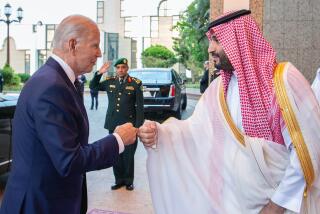Saudis Chart New Course on Oil, Regional Stability
- Share via
For 24 years, Sheik Ahmed Zaki Yamani, oil minister in Saudi Arabia, has been a prominent and influential fixture on the international scene. His dismissal last week is seen as the end of one era and the start of another. Yamani presided over the era of oil power--especially Saudi oil power--and in a way, he has fallen victim to its demise.
During the last year and a half, two key Saudi policies with which Yamani was identified both failed. The first was to try maintaining oil prices by cutting production. As a result, at one point Saudi oil exports fell to about 2 million barrels per day, one-quarter of peak levels in 1979. But it wasn’t enough, especially when other members of the Organization of Petroleum Exporting Countries breached their quotas and non-OPEC producers failed to cooperate. The kingdom’s oil income dropped sharply, leading to heavy pressure on its financial assets, economic problems and criticism at home.
The next Yamani-led policy was OPEC’s attempt to defend its share of the global oil market. Now the Saudis urged an increase in production to push oil prices down. This would lead the industrial states to begin using more oil; it would reduce conservation and shut out higher-cost sources of energy. And OPEC would regain a larger share of the market. In the long term, the theory went, oil prices would stabilize in the range of $15 to $18 a barrel. OPEC oil would continue to be in demand, while waiting for markets to tighten in the 1990s.
The Saudis calculated that they would benefit most from this policy because of their vast capacity to produce and export. They hoped to gain through sales volume what they would lose through lower prices.
Riyadh also discovered that lower oil prices put heavy economic pressures on Iran, so intensifying these pressures seemed a means of convincing Iran to compromise in the war with Iraq and ease regional tensions.
This complex theory was elegant--and wrong. Oil prices dropped too far and too fast, and $5 a barrel loomed. Even greatly increased production would not substantially boost Saudi income, ease domestic economic pressures and end grumbling.
Nor did Iran, despite its acute economic problems, face imminent collapse or move toward compromise on the war. It did, however, indicate willingness to compromise on regional issues. In September, it floated the idea of some kind of security arrangements with the Gulf Arab states, and the Iranian and Saudi foreign ministers met at the U. N. General Assembly.
Meanwhile, Saudi oil policy came under severe pressure from other producers--OPEC and non-OPEC--and key regional countries like Egypt. During the August meeting of OPEC oil ministers, nine members and some non-OPEC oil producers appealed directly to King Fahd. The result was a temporary agreement to curtail production in order to stabilize prices.
Yet the debate was reopened in October, when Kuwait demanded a higher production quota. Another fall in oil prices seemed imminent. When the dust settled after a 17-day session of the oil ministers, they agreed to extend the temporary quotas for two months, but oil markets were unconvinced and prices failed to rise.
The facts of economic life mean that Saudi Arabia no longer dominates oil pricing--and Zaki Yamani was the personification of that change. His continued presence also symbolized the risk that Saudi Arabia would again try the discredited price-war strategy. And it became clear that Riyadh cannot both pursue such a strategy and try to influence Iran.
Thus if the Saudis wanted to change their position, and if the king wanted to distance himself from failed policies, the tool was at hand: Shoot the messenger. It also had the virtue of removing a man who had ruffled quite a few feathers in OPEC.
The full implications of Sheik Yamani’s departure for Saudi Arabia’s oil and regional policies will become clear when Riyadh takes further action. But dismissing the symbol of their place in the oil world likely signals the Saudis’ willingness to be less unilateralist and more cooperative within OPEC--helping to stabilize oil prices at about $18 a barrel, for example. And it likely signals greater Saudi willingness to seek regional accommodation with Iran, provided the latter proves sincere in its expressed desire to do the same.
Yamani’s departure may signal even more than that: It may indicate the onset of a basic reassessment of Saudi Arabia’s security and foreign policies, both in the region and beyond. In that event, its close identification with the West would no longer be beyond question.
More to Read
Sign up for Essential California
The most important California stories and recommendations in your inbox every morning.
You may occasionally receive promotional content from the Los Angeles Times.













